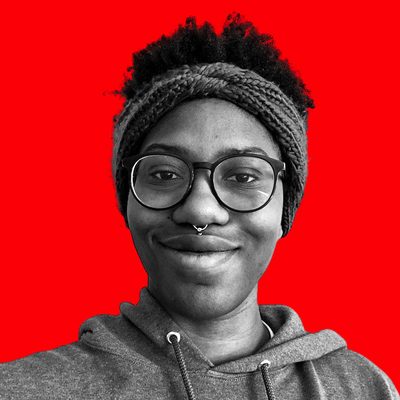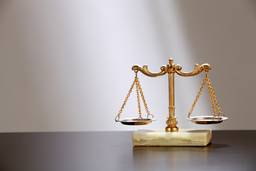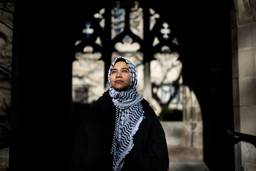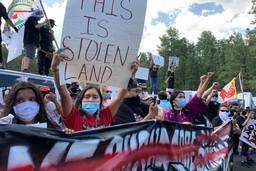I Shouldn’t Have to Be a “Strong Black Woman” for My Life to Matter
Support Black women when we are loud or quiet, when we are brave or scared, when we are fed-up or meek.
Ramenda Cyrus
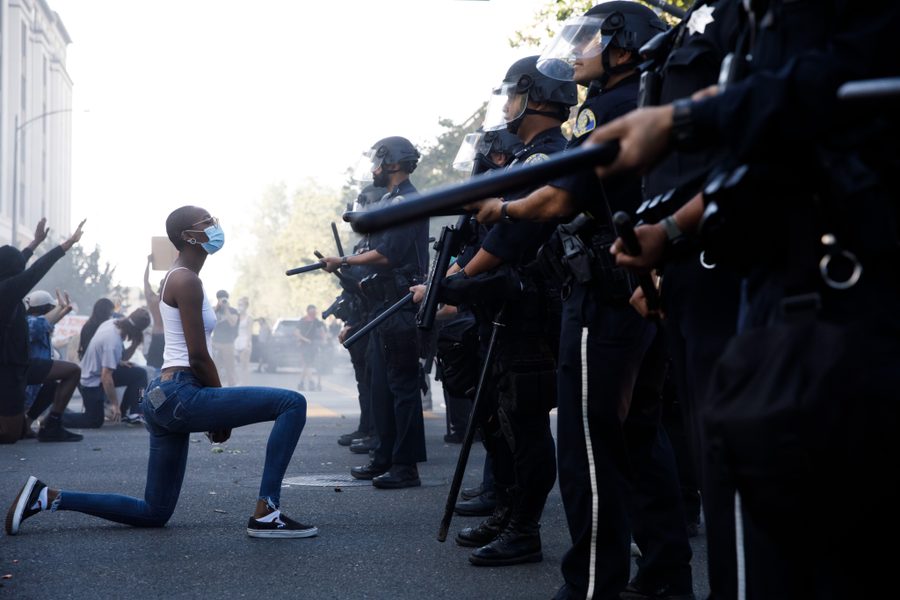
In May 2020, a young Black woman kneels in front of riot police with nothing but a face mask. In August 2016, Ieshia Evans calmly approaches riot-armed police and is promptly taken into custody. Over 50 years ago, Gloria Richardson pushes a rifle away from her in apparent exasperation and outrage.
This type of photo — where the Black woman is unabashed and unafraid in her protest — emerges often. The murder of George Floyd at the hands of Minneapolis police that sparked world-wide, almost daily protests for weeks was no exception. During these protests, I have seen these images circulating without any meaningful discussion of what they represent. These photos remind the public that Black women have always been on the front lines of anti-racism movements.
As a Black woman, these photos terrify me. They are powerful representations of our strength and tenacity, yet they contribute to the burden Black women carry everyday.
We rarely see convictions or indictments for Black men dying at the hands of police, but we do see massive movements dedicated to them. The Civil Rights Movement grew in response to, among other things, the death of Emmett Till in 1955. Black Lives Matter gained national attention in response to protests over Michael Brown’s death in 2014. The massive protests this year were sparked by George Floyd’s death.
Black women have been integral to these protests and to the Black Lives Matter movement in general, just as during the Civil Rights Movement.
People are right to protest the racist murder of any Black person. But, as noted in “Say Her Name: Resisting Police Brutality Against Black Women,” the deaths of Black women are not getting similar attention, and “our silence around the killing of Black women and girls sends the message that their deaths are acceptable and do not merit repercussions.”
It is an ugly truth to say that this has burdened us. The movement, while glowing and active at the moment, has become complacent when it comes to Black women. Photos like these allow people to see us as the unshakeable face of the movement, which only plays into the oft-criticized trope of the Strong Black Woman, where Black women are portrayed as upfront, always in control, and never vulnerable.
The Strong Black Woman is more than just a media trope, though. It is a pervasive myth that will continuously harm Black women as long as the movement and society at large demands Black women’s attention and energy without giving anything back.
On the podcast “15 Minutes on the Couch, Ayanna Abrams, a licensed clinical psychologist, puts its origins at slavery and the different roles Black women played in their own families and the families they were owned by.
“They had to play this role in which they were always doing, always caring, always serving, always taking care of other,” she says. “That transitions through generations, through decades, quite literally through centuries. And now we are up against this myth and this trope that has taught us that we are on the bottom of the list… or that we’re not even actually on the list.”
These photos reinforce this harmful myth because they create the expectation that I, as a Black woman, put my body on the frontline. They reinforce the expectation that I must always be brave in the face of racism or violence.
I resist this idea because I am a Black woman who is afraid. I am a Black woman who cries over the pain our people have been subjected to, who becomes locked up with anxiety at the thought of an encounter with the police. On top of this, I often fear no one is fighting for me, but instead expecting me to fight for myself and everyone else.
I resist this idea because, despite these photos, we know of so many Black women who encounter the police and do not survive.
#SayHerName is a hashtag dedicated to Black cis- and trans- woman victims of police brutality. It grew out of the need to shed light on the fact that Black women are dying by police hands too, and that we are rarely getting justice or even media attention.
The need for this hashtag is exemplified by the death of Sandra Bland, who I think about daily. Bland likely knew she was about to have an uncomfortable — potentially dangerous — encounter, as it recently came to light that she filmed it on her phone. Then she got out of the car and reminded the officer that he was overreacting by actively threatening her.
“Yeah, let’s take this to court,” Bland said. She acted brave in the face of racism and violence, the way Black women are expected to.
Bland was dead 72 hours later. Suicide, the authorities said, and the grand jury deliberated for over eight hours before returning no indictments for her death and handing legitimacy to the iffy (at best) story where she hung herself with a trash bag.
Outcry over Bland’s death resulted in the “Sandra Bland Act” being passed in Texas in 2017. But Rep. Garnet Coleman, who wrote it in partnership, acknowledged that during negotiations it was stripped of important reform tenets focused on regulating the interactions of Texas police with the public, and it became “a mostly mental health bill.”
It was heartwarming to see many people remember her on the most recent anniversary of her death, and many did call for justice on that day. The African American Policy Forum (AAPF) that started #SayHerName in partnership with Center for Intersectionality and Social Policy Studies (CISPS) mentions her in, “Say Her Name: Resisting Police Brutality Against Black Women” under “Driving While Black.”
And there were protests in her name in the immediate aftermath of her death. Certainly, Bland lives on in our protests for justice for murdered Black women such as Breonna Taylor or Natasha McKenna. While we are demanding that Taylor’s murderers be arrested, charged and tried, calls to reopen Bland’s investigation are met with attitudes like that captured in the New York Times headline, “The Death of Sandra Bland: Is There Anything Left to Investigate?”
For the Times, David Montgomery writes, “Both her mental health background and the physical evidence in the autopsy report pointed to suicide,” despite the continuous demands from her family to reopen the case and the compelling argument that, as Matt Taibbi wrote for Rolling Stone, “Suicide or not, police are responsible for Sandra Bland’s death.”
To some, the circumstances around Bland’s death might make it harder to fight for her. While Breonna Taylor was rudely awakened and almost immediately shot, the fact that Bland was not kowtowing to Encinia’s demands was painted, for his defense, as reason enough to treat her the way he did.
“My safety was in jeopardy at more than one time,” Encinia said. His perjury indictment was thrown out in exchange for a promise to never work in law enforcement again, which I find blasphemous.
The whole investigation was a sham, and demanded far more outrage. If a yard sign or street mural is performative, trials that bring no justice, and laws such as “Breonna’s Law” and the “Sandra Bland Act” that do not address the systemic oppression which has resulted in such rampant police brutality, are as well. This is what “Defund The Police,” the call to dismantle police forces and redistribute resources to community health, is all about.
There’s more we can do, though.
The movement can only move forward. We can still honor Bland — and all Black women killed or terrorized by police — by supporting Black women when we are loud or quiet, when we are brave or scared, when we are fed-up or meek.
Because right now, there is nowhere for us to be vulnerable, and no one protecting us. Black women are quite literally on the frontlines of this fight and the least the rest of the movement can do is let us cry and yell and curse.
Abrams is also the founder of Not So Strong, a space made for Black women to express emotion and be vulnerable with each other. It is an example of how we can be active in creating space for Black women, but there is more we can do alongside this.
White people can choose to be active in the fight against racism and center the voices of Black women in their protests, and Black men can start listening to us and working on cultural issues with us.
At the very least, stop taking these pictures and plastering them over the internet. We do not need anymore of the sort, but we do need healing spaces for Black women. If we can hold vigils and protests, we can dedicate space to the voice and the pain of Black women. Not just people of color or Black people, but Black women.
Let us speak. Let us rage. Let us sigh. Let us be vulnerable in any way we see fit in the moment, and fight for us regardless.
